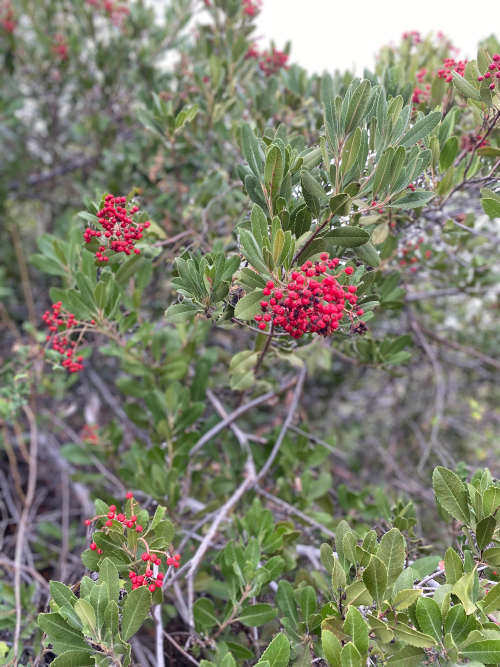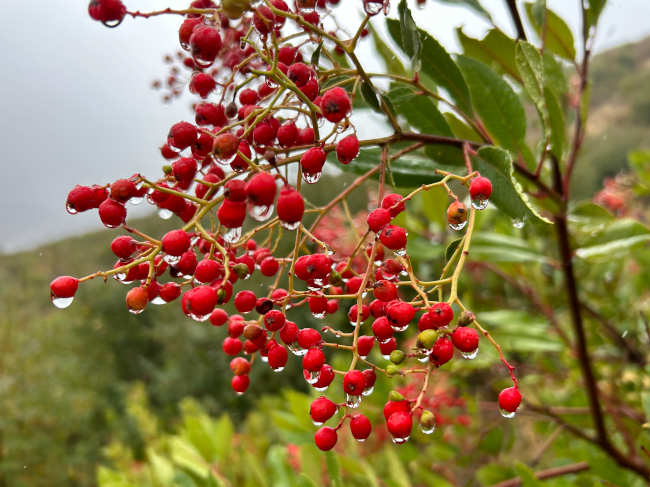
NORTHERN CALIFORNIA — On a recent hike through Molok Luyuk, the newest addition to the Berryessa Snow Mountain National Monument, one couldn’t help but notice the dark green shrub with the shouty red berries from across the canyon.
You didn’t really have to search for it, all you needed to do was lift your eyes from the toes of your boots and glance across the landscape.
There, in a sea of gray-green foliage, “Christmas berry” conspicuously stood out like the one (delicious) black-licorice jellybean in a bowl of brightly colored fruity flavors. The entire shrub is quite showy with large, shiny leaves and chunky clusters of splashy red berries.
Christmas berry, also known as Christmas holly and toyon, are all common names for Hetermoleles arbutifolia.
Toyon belongs to the very diverse rose family (Roseaceae) but is the sole constituent of the genus Hetermoleles.
Other members of the rose family include cultivated crops such as apples, peaches, plums and strawberries as well as native species such as California rose (Rosa californica) and chamise (Adenostoma fasciculatum), and many, many others.
Christmas berry is a woody shrub that occurs along the foothills of Central California and in the Coastal Ranges from Humboldt County south to Baja California.
It is commonly, but not always, found on north-facing slopes usually below 4,000 feet in woodlands, forest and chaparral habitats alongside a variety of other species such as coyote bush, coffee berry and live oaks.
The name “toyon” is believed to have been used by the indigenous Ohlone people of historic Central California. It is also thought that the name toyon could have come from an old Spanish word meaning “canyon,” which is where it frequently occurs.
In fact, the striking presence of Christmas holly among the adjacent foothills is thought to have been the namesake for the famed Southern California neighborhood now called “Hollywood.”
Native to California, Christmas berry has adaptations that help it not only survive but thrive in our Mediterranean climate. The thick leaves are leathery and waxy which helps them retain moisture during our scorching summers. It also remains green all year long, which makes the plant less flammable than neighboring chaparral species that readily combust.
Underground, the roots are thoroughly branched and sprawling to help it acquire moisture from the surrounding soil.
The wood is very hard and was used to make tools and weapons while the leaves were used for wound care by Native Californians.
Although the leaves and unripe berries contain a cyanide compound which can cause sickness or even death, as the fruit matures it becomes concentrated only in the seed. This aids in plant dispersal as birds and small mammals eat berries and distribute seeds elsewhere without harming them.
The cyanide compounds remain in the leaves which may help deter browsing by deer and elk. The ripe berries are described as sweet to spicy and bitter.
Native Americans used them as a food source after roasting or drying to remove the bitterness and rarely ate them raw.
Pioneers used the berries in custards, jams, pies and fermented them as a type of cider beverage; the process of fermentation or cooking deactivates the cyanide compound - seems like kind of a tough trial and error lesson.
Sprigs of Christmas berry were often used commercially in place of English holly for Christmas decorations.
By the 1920s Christmas berry was harvested so severely that it was nearly extirpated from within Southern California prompting the state to pass a law making collection of the plant illegal.
In 2012, Christmas berry was adopted as the official native plant of Los Angeles by the Los Angeles City Council. It can be cultivated and grown in domestic gardens in well-drained soil and has even gotten popular as an ornamental in Southern England.
Butterflies love the flowers and the berries are an important winter food source for many resident bird species including California quail, northern mockingbirds, scrub jays as well as migrating species such as cedar waxwings.
Kristie Ehrhardt is Land Conservation and Stewardship Program director for Tuleyome, a 501(c)(3) nonprofit conservation organization based in Woodland, California. For more information go to www.tuleyome.org.


 How to resolve AdBlock issue?
How to resolve AdBlock issue? 



